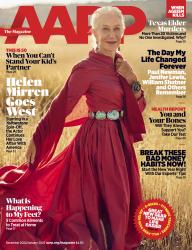Helen Mirren Shares Passions for America and Reveals ‘All My Boyfriends Had to Have a Shirt Made By Me’ in Exclusive AARP The Magazine Interview
The iconic, award-winning actress on taking creative liberty in her roles, wrangling horses, the joys of being in a Western, and finally having her own action figure
WASHINGTON – Helen Mirren may be known for her dramatic roles, several of them playing British royalty, but the 77-year-old Emmy-, Tony-, and Academy Award-winning actress remains game to take on new challenges. AARP The Magazine (ATM) caught up with Mirren in Butte, Montana, where she is filming the Western TV series 1923, with whom she co-stars with Harrison Ford (the series premieres December 18, 2022 on Paramount+) to discuss her impressions of America, horse riding, and the many talents she has developed throughout her expansive career.
The London-born actress dives into the importance of portraying accurate representations of her characters onscreen, the tireless practice that goes into perfecting her craft, her love of fashion, and embracing the natural changes that come with age. Mirren also shares her excitement over her upcoming action figure (she will play the villain Hespera in Shazam! Fury of the Gods, in theaters March 17, 2023), her love of making clothing by hand, and a new skill she just learned this year for a role: learning how to drive a horse-drawn buggy.
Mirren also shares her lifelong passion for clothes making, and that “all my boyfriends had to have a shirt made by me … Very bad shirts.”
The following are excerpts from ATM’s December 2022/January 2023 cover story featuring Helen Mirren. The issue is available in homes starting in December and online now at www.aarp.org/magazine/.
On making shirts and giving them to boyfriends – including Liam Neeson:
“I did make one for Liam, oddly enough,” she says. After a moment, she adds: “We loved each other. We were not meant to be together in that way, but we loved each other very, very much. I love him deeply to this day. He’s such an amazing guy.”
On her first time in the American West and drinking with cowboys:
“I was in San Francisco with the Royal Shakespeare Company, and our next gig was in Detroit four days later. So, several of us took the train. That train ran across the desert, through the Rockies, then through forests, and more desert. It gave me my first eye on America. The train would stop in the middle of a town with no train station or anything. I remember stopping in Cheyenne, getting off the train, going into a bar and having a drink with a couple of cowboys, then getting straight back on the train again.”
On the representation of Western films leading up to her series 1923:
“I’ve always loved Westerns. I grew up watching Wagon Train on my neighbor’s telly. But one thing that has always annoyed me about westerns is that the characters were all simply Americans, as if they’d been there all along.”
“Here in Butte, at the turn of the century, people came from Cornwall, from Wales, many came from Ireland, from Montenegro, from all sorts of different European mining areas. And from Asia. I love imagining that cacophony of accents. So I thought it would be good if Cara were an immigrant. I’m playing her with a Irish accent, working on the theory that Cara never really lost that accent when she got here, which feels a bit like me. I had an accent when I arrived in America and I’ve never lost it.”
On learning how to drive a buggy:
“Driving two horses is harder than one,” she says. “When there are two of them, they tell each other what to do; whereas a single horse, he or she is listening only to you.”
The horse wrangler for 1923, movie veteran Diane Branagan, got a great sense of how Dame Helen works. “She’s a sponge, she absorbs everything and practices tirelessly, and practices perfectly too, which is probably what makes her a great actor. The horses need to know that you are looking ahead, at the horizon. You have to know where you’re going, and keep your eye out. Helen’s very good at communicating that. She sees what’s ahead.”
On embracing change and New Year’s resolutions:
“Well, the thoughts that you have when you’re 16, you have exactly the same thoughts when you’re 76, which is very annoying. And every year I make the same New Year’s resolutions: I will not procrastinate. And every year I procrastinate. I will be more communicative. And every year, I fail to be communicative. Certain character failings stay with you forever, it seems to me.
“But in another way, we change totally. I mean I am a completely different person compared to the person I was at 22 or 23. Even your skin changes. Your body changes. What you can and can’t do, what you’re capable of, changes; the way you think changes.”
# # #
About AARP
AARP is the nation’s largest nonprofit, nonpartisan organization dedicated to empowering people 50 and older to choose how they live as they age. With a nationwide presence and nearly 38 million members, AARP strengthens communities and advocates for what matters most to families: health security, financial stability and personal fulfillment. AARP also produces the nation’s largest circulation publications: AARP The Magazine and AARP Bulletin. To learn more, visit www.aarp.org, www.aarp.org/espanol or follow @AARP, @AARPenEspanol and @AARPadvocates, @AliadosAdelante on social media.
































































